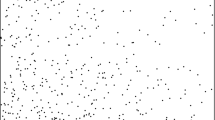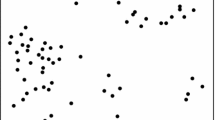Abstract
This paper proposes an estimation method for superposed spatial point patterns of Neyman–Scott cluster processes of different distance scales and cluster sizes. Unlike the ordinary single Neyman–Scott model, the superposed process of Neyman–Scott models is not identified solely by the second-order moment property of the process. To solve the identification problem, we use the nearest neighbor distance property in addition to the second-order moment property. In the present procedure, we combine an inhomogeneous Poisson likelihood based on the Palm intensity with another likelihood function based on the nearest neighbor property. The derivative of the nearest neighbor distance function is regarded as the intensity function of the rotation invariant inhomogeneous Poisson point process. The present estimation procedure is applied to two sets of ecological location data.








Similar content being viewed by others
References
Akaike, H. (1974). A new look at the statistical model identification. IEEE Transactions on Automatic Control, AC-19, 716–723.
Baddeley, A., Turner, R. (2000). Practical maximum pseudolikelihood for spatial point patterns. Australian & New Zealand Journal of Statistics, 42, 283–322.
Baddeley, A., Barany, I., Schneider, R., Weil, W. (2007). Stochastic Geometry Lecture Notes in Mathematics 1892. Berlin: Springer.
Baudin, M. (1981). Likelihood and nearest-neighbor distance properties of multidimensional Poisson cluster processes. Journal of Applied Probability, 18, 879–888.
Cressie, N. (1993). Statistics for Spatial Data. New York, Chichester: John Wiley & Sons.
Daley, D. J., Vere-Jones, D. (1988). An Introduction to the Theory of Point Processes. New York: Springer.
Daley, D. J., Vere-Jones, D. (2003). An Introduction to the Theory of Point Processes, Volume I: Elementary Theory and Methods (2nd ed.). New York: Springer.
Daley, D. J., Vere-Jones, D. (2008). An Introduction to the Theory of Point Processes, Volume II: General Theory and Structure (2nd ed.). New York: Springer.
Diggle, P. J. (1983). Statistical Analysis of Spatial Point Patterns. London: Academic Press.
Guan, Y. (2006). A Composite Likelihood Approach in Fitting Spatial Point Process Models. Journal of the American Statistical Association, 101, 1502–15012.
Guan, Y., Jalilian, A., Waagepetersen, R. P. (2011). Optimal Estimation of the Intensity Function of a Spatial Point Process, Research Report, Centre for Stochastic Geometry and Advanced Bioimaging, No. 07, Department of Mathematical Sciences, Aarhus University, Denmark.
Hutchings, M. J. (1979). Standing crop and pattern in pure stands of Mercurialis perennis and Rubus fruticosus in mixed deciduous woodland. Oikos, 31, 351–357.
McKeague, I.W., Loizeaux, M. (2002) Perfect sampling for point process cluster modeling, Spatial Cluster Modelling, eds. A. B. Lawson and G. T. Denison, 87–107, Florida: Chapman & Hall/CRC Press.
Møller, J., Waagepetersen, R. P. (2007). Modern statistics for spatial point processes. Scandinavian Journal of Statistics, 34, 643–684.
Mrkvička, T., Molchanov, I. (2005). Optimisation of linear unbiased intensity estimators for point processes. Annals of the Institute of Statistical Mathematics, 57, 71–81.
Neyman, J., Scott, E. (1958). Statistical approach to problems of cosmology. Journal of the Royal Statistical Society. Series. B, 20, 1–43.
Ogata, Y., Katsura, K. (1991). Maximum likelihood estimates of the fractal dimension for random spatial patterns. Biometrika, 78, 463–474.
Ogata Y., Tanaka U. (2013). Searching for locations of parents from superposed clusters, Research Memo., No.1175, The Institute of Statistical Mathematics, Tokyo.
Proke\(\breve{s}\)ová, M., Vedel Jensen, E. B. (2013). Asymptotic Palm likelihood theory for stationary point processes. Annals of the Institute of Statistical Mathematics, 65, 387–412.
Rathbun, S. L., Cressie, N. (1994). A space-time survival point process for a longleaf pine forest in Southern Georgia. Journal of the American Statistical Association, 89, 1164–1174.
Ripley, B. D. (1977). Modelling spatial patterns. Journal of the Royal Statistical Society. Series B, 39, 172–212.
Stoyan, D., Stoyan, H. (1994). Fractals, Random Shapes and Point Fields. Chichester: John Wiley & Sons.
Stoyan, D., Stoyan, H. (1996). Estimating pair-correlation functions of planar cluster processes. Biometrical Journal, 38, 259–271.
Tanaka, U., Ogata, Y., Katsura, K. (2008a). Simulation and Estimation of the Neyman–Scott Type Spatial Cluster Models. Computer Science Monographs, 34, 1–44.
Tanaka, U., Ogata, Y., Stoyan, D. (2008b). Parameter estimation and model selection for Neyman–Scott point processes. Biometrical Journal, 50, 43–57.
Thomas, M. (1949). A generalization of Poisson’s binomial limit for use in ecology. Biometrika, 36, 18–25.
Van Lieshout, M. N. M., Baddeley, A. J. (1996). A nonparametric measure of spatial interaction in point patterns. Statistica Neerlandica, 50, 344–361.
Van Lieshout, M. N. M., Baddeley, A. J. (2002). Extrapolating and interpolating spatial patterns, Spatial Cluster Modelling, eds. A. B. Lawson and G. T. Denison, 61–86, Florida: Chapman & Hall/CRC Press.
Waagepetersen, R. (2007). An estimating function approach to inference for inhomogeneous Neyman–Scott processes. Biometrics, 63, 252–258.
Acknowledgments
The authors are grateful to Koichi Katsura for his generous help in programming matters and to Jancang Zhuang for his helpful advice related to the graphical software R. This study is partially supported by Grant-in-Aid 23240039 for Scientific Research (A), Ministry of Education, Science, Sports and Culture. Y.O. was supported by the Aihara Innovative Mathematical Modelling Project and the Japan Society for the Promotion of Science (JSPS) through the ‘Funding Program for World-Leading Innovative R&D on Science and Technology (FIRST Program)’, initiated by the Council for Science and Technology Policy (CSTP).
Author information
Authors and Affiliations
Corresponding author
About this article
Cite this article
Tanaka, U., Ogata, Y. Identification and estimation of superposed Neyman–Scott spatial cluster processes. Ann Inst Stat Math 66, 687–702 (2014). https://doi.org/10.1007/s10463-013-0431-z
Received:
Revised:
Published:
Issue Date:
DOI: https://doi.org/10.1007/s10463-013-0431-z




